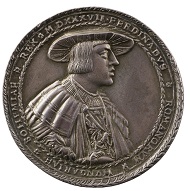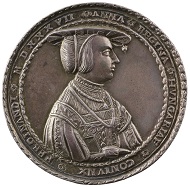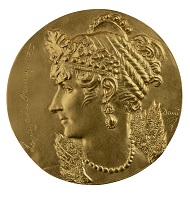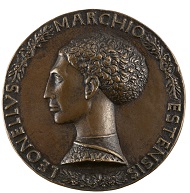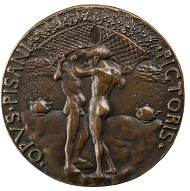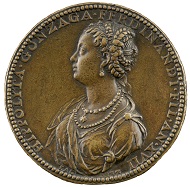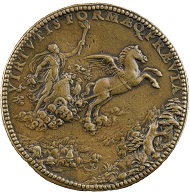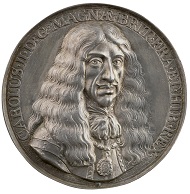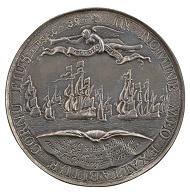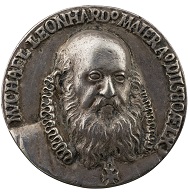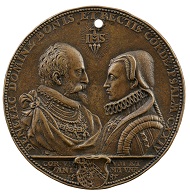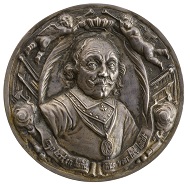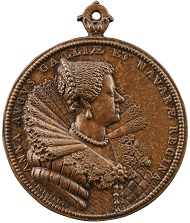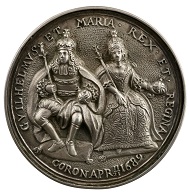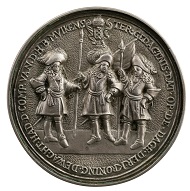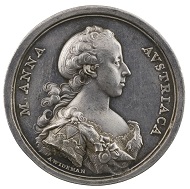May 19, 2016 – The Frick is pleased to announce a promised gift of portrait medals from the Stephen K. and Janie Woo Scher Collection. Considered to be the world’s greatest medals collection in private hands, rivaling and often surpassing those in American museums such as the National Gallery of Art, The Metropolitan Museum of Art, and the Los Angeles County Museum of Art, it is noted for its comprehensiveness and outstanding quality.
Wolf Milicz (active 1533-46), Ferdinand I, 1537. Silver, 46.8 mm. Stephen K. and Janie Woo Scher Collection. Photo: Michael Bodycomb.
An initial gift of about 450 medals will beautifully trace the development of the art of the medal from its inception in the fifteenth century through the nineteenth century. Among the strengths of the collection – which includes examples from Italy, France, Germany, England, and The Netherlands – are superlative works by the masters Pisanello (Italy), Dupré (France), Reinhart (Germany), and Jonghelinck (Netherlands).
David d’Angers (1788-1856), Empress Josephine Lapagerie Bonaparte, ca. 1804. Gilt bronze, 177.8 mm. Stephen K. and Janie Woo Scher Collection. Photo: Michael Bodycomb.
A selection of the portrait medals will be featured in a major spring/summer exhibition opening in May of 2017. The show will be accompanied by public programming and an in-depth scholarly publication that catalogs the entirety of this important collection.
Pisanello (ca. 1395-ca. 1455), Leonello d’Este / Two Men with Baskets (reverse), ca. 1445. Bronze, 68.9 mm. Stephen K. and Janie Woo Scher. Collection.; Photo: Michael Bodycomb.
Comments Director Ian Wardropper, “Henry Clay Frick had an abiding interest in portraiture as expressed in the paintings, sculpture, enamels, and works on paper he acquired. The Scher medals will coalesce beautifully with these holdings, being understood in our galleries within the broader contexts of European art and culture. At the same time, the intimate scale of the institution will offer a superb platform for the medals to be appreciated as an independent art form, one long overdue for fresh attention and public appreciation.”
Jacopo Nizzola da Trezzo (1515/19-1589), Ippolita Gonzaga, 1552. Bronze, 68.8 mm. Stephen K. and Janie Woo Scher Collection. Photo: Michael Bodycomb.
Adds Peter Jay Sharp Chief Curator Xavier F. Salomon, “The Frick and the Schers have enjoyed a lengthy and rewarding relationship. Stephen Scher organized the landmark exhibitions The Currency of Fame (The Frick Collection and the National Gallery of Art, 1994) and The Proud Republic: Dutch Medals of the Golden Age (The Frick Collection, 1997). A world-renowned scholar, Dr. Scher has the ability to instill in new audiences an enthusiasm and appreciation for these remarkable objects. He brings to life these masterpieces of small-scale sculpture, compellingly conveying the circumstances of their creation and their historic significance today. The Frick has enjoyed hosting Dr. Scher as an educator on many occasions, from large public lectures to intimate scholarly seminars and school groups, and we look forward to developing programs with him in conjunction with the upcoming exhibition.”
Jean Dacier, George I, 1727. Bronze (parcel gilt), 31.7 mm. Stephen K. and Janie Woo Scher Collection. Photo: Michael Bodycomb.
Henry Clay Frick most often acquired works individually, but occasionally he purchased groups of objects from significant collections. For example, in 1915, he acquired Limoges enamels and Renaissance bronzes from the estate of J. P. Morgan. In recent years, the institution has accepted important collections that amplify specific areas of its holdings, such as Winthrop Kellogg Edey’s bequest of clocks and timepieces (1999) and Henry Arnhold’s promised gift of Meissen porcelain (2008).
Pieter van Abeele (1608-1684), Charles II, King of England, 1660. Silver, 68.5 mm. Stephen K. and Janie Woo Scher Collection. Photo: Michael Bodycomb.
The Stephen K. and Janie Woo Scher Collection does something very special for the Frick. Given its sweeping scope across historical periods and the wide range of its subject matter, it will resonate with almost every work in the Frick’s permanent holdings.
Baldwin Drentwett (1545-active until 1627), Michael Leonhard Maier, 1580. Silver, 41.6 mm. Stephen K. and Janie Woo Scher Collection. Photo: Michael Bodycomb.
As such the Scher medals will enrich the experience of the museum’s viewing audience and stimulate scholarship on existing holdings in previously unanticipated ways.
Attributed to Hubert Gerhard (ca. 1540-1550, d. before 1621). Wilhelm V and Renata von Lothringen, 1585. Bronze, 77.1 mm. Stephen K. and Janie Woo Scher Collection. Photo: Michael Bodycomb.
For example, Italian Renaissance medals by Pisanello, Bertoldo, and Antico directly relate to the Frick’s important works by these artists. German and English medals will provide an artistic context for Holbein’s paintings of Thomas More and Thomas Cromwell, as well as for the Frick’s small, superb collection of German drawings and Dürer prints.
Wouter Müller (1604-1673). Maarten Harpertszoon Tromp (Lieutenant-Admiral of Holland), 1653. Silver, 75.0 mm. Stephen K. and Janie Woo Scher Collection. Photo: Michael Bodycomb.
Seventeenth-century Netherlandish medals will add a much needed sculptural component to the Frick’s exceptional collection of seventeenth-century Dutch and Flemish paintings and bronze masterpieces such as the bust of the Duke of Alba by Jonghelinck.
Guillaume Dupré (1574 or 1576-1643), Louis XIII / Anne of Austria (reverse), 1620. Bronze, 59.7 mm. Stephen K. and Janie Woo Scher Collection. Photo: Michael Bodycomb.
Medals by Pilon and Dupré will enhance the Frick’s strong collection of French Renaissance and Baroque objects represented by the Limoges collection, French clocks, and seventeenth-century French sculpture.
Unknown Artist, Coronation of William and Mary, 1689. Silver, 62.7 mm. Stephen K. and Janie Woo Scher Collection. Photo: Michael Bodycomb.
Medals will also make a significant contribution to portraiture, one of Henry Clay Frick’s primary collecting interests and the genre most closely identified with the Frick. For example, isolated masterpieces such as Bronzino’s portrait of Ludovico Capponi will be enriched with the addition of Italian mannerist medals by Abondio and the Leoni.
Anton Franz Widemann (1724-92), Maria Anna of Austria, 1766. Silver, 42.9 mm. Stephen K. and Janie Woo Scher Collection. Photo: Michael Bodycomb.
Seventeenth-century Netherlandish silver medals vividly commemorate the political achievements and economic power that generated the flowering of the Golden Age of Dutch painting represented at the Frick by the portraits of Rembrandt and Hals. Finally, nineteenth-century French portraits, such as David’s Comtesse Daru and the bust of Etienne Vincent-Marniola by Chinard, will offer important points of connection to the revival of the medallic arts during the Napoleonic era.
Adds Director Ian Wardropper, “Although Henry Clay Frick did not collect medals, the beauty, artistry, and historical importance of the works in the Scher collection are in complete harmony with the founder’s collecting ethos.”
To learn more about The Frick Collection click here.





